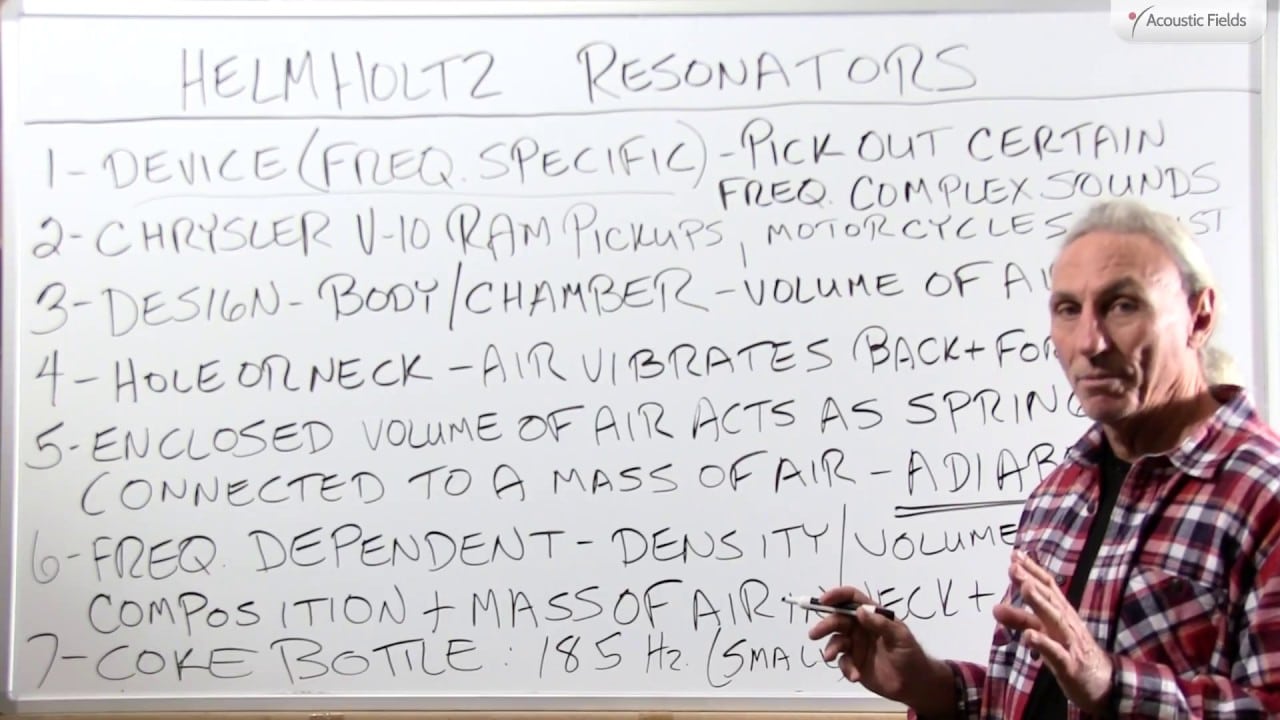Today we’re going to talk about Helmholtz Resonators. Obviously this is a term that’s very common in the literature, a lot of people talk about them, I get a lot of calls about them, why don’t we use a Helmholtz instead of a diaphragmatic, why don’t we use a Helmholtz instead of a membrane, always type, amount and position in a room. So let’s walk through what Helmholtz really are so you get a feel for them. They’re really a sound absorption device that’s very frequency specific, they’re very narrow in the amount of absorption, you might get 40 cycles to 45, you may get a five Hertz window with them but you never get anything more than that so you need a lot a lot of them tuned to different frequencies. They can be very effective but you need a lot of units in a room to deal with all the problems that Small Room Acoustics Low Frequency Energy Management contains.
So they’re not really used a lot in Small Room Acoustics because of that but I think it’s going to be interesting to kind of walk through the process. So it’s used today in cars because they pick out certain frequencies out of complex sounds, if you have a 4o to a 43 cycle range you want to absorb some of and that smooth it out so it blends with the other octaves in that range, you can do that. Helmholtz Resonators are used in Chrysler products, the Ram –pickups, they use them a lot, motorcycle exhaust they use them. I’m actually designing a Helmholtz resonator now for Scania which is a truck company in Sweden. We have an exhaust system that’s really noisy so we’ve measured the noise and then we’re going to design some of our carbon technology within a Helmholtz resonator to deal with that noise.
So let’s talk a little bit about the resonator itself, what it is, it’s like a body or a chamber we’ve all seen them. It’s a body or a chamber and then it’s got a neck or you could look at something like this so it has a neck and obviously energy moves through that, goes down through here and then gets the air molecules inside going. So we have the neck, we have the body, we have the opening, you can see we have a lot of variables that we have to deal with here so resonators are difficult, you have to understand the physics of many many parts of them in order to get them to work right. We have the hole or neck air vibrating back and forth and then the air inside the resonator acts as a spring okay so you get a lot of air inside of it moving up and down like a spring. Then that is connected to the total mass of air in there so you have this mass of air defined by the size of the container, the opening of the neck, the narrowness of the neck and then that mass of air moves up and down as a spring. The term for that is adiabatic, so not diabetes but adiabatic, it’s a process that we use in physics.
So how does it influence what we do? Well it’s very frequency dependent because we have a certain size, we have a certain volume and we have a certain size of our opening and all three of those variables have to be controlled. It’s the composition also of the diaphragm or of the Helmholtz resonator itself that has bearing on what we’re trying to do, the neck and obviously the chamber so lots of variables, lots of calculations, it takes a little bit of experience and testing. Here’s a good example of a Helmholtz resonator that we’re all familiar with and that’s a small glass coke bottle, you blow across the opening on that which we’ve all done, it’s about 185 cycles. So what does that mean? Anything above 185 cycles will be absorbed, anything below it will not so that’s the resident frequency of that Helmholtz resonator. So I hope this helps, just remember it’s a chamber with air, you’re forcing air through a neck and all of that volume of the chamber, the diameter of the neck and the diameter of the slot all has to be calculated.
—
This is an unedited transcript from our video series from Acoustic Fields. There will be some errors in grammar and sentence structure that occur during this translation process.
For complete understanding and comprehension, please view the video which is included in this text. For any additional information regarding this topic or others relating to room acoustics, please contact us directly at:
P: 520 – 392 – 9486







